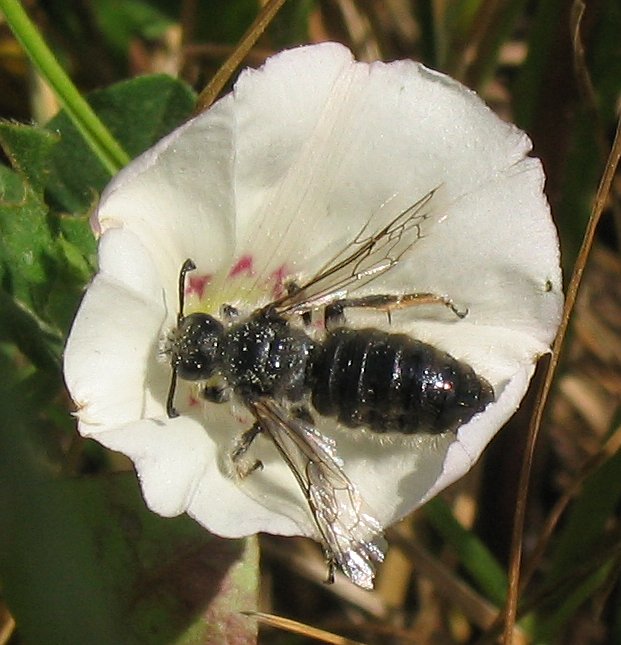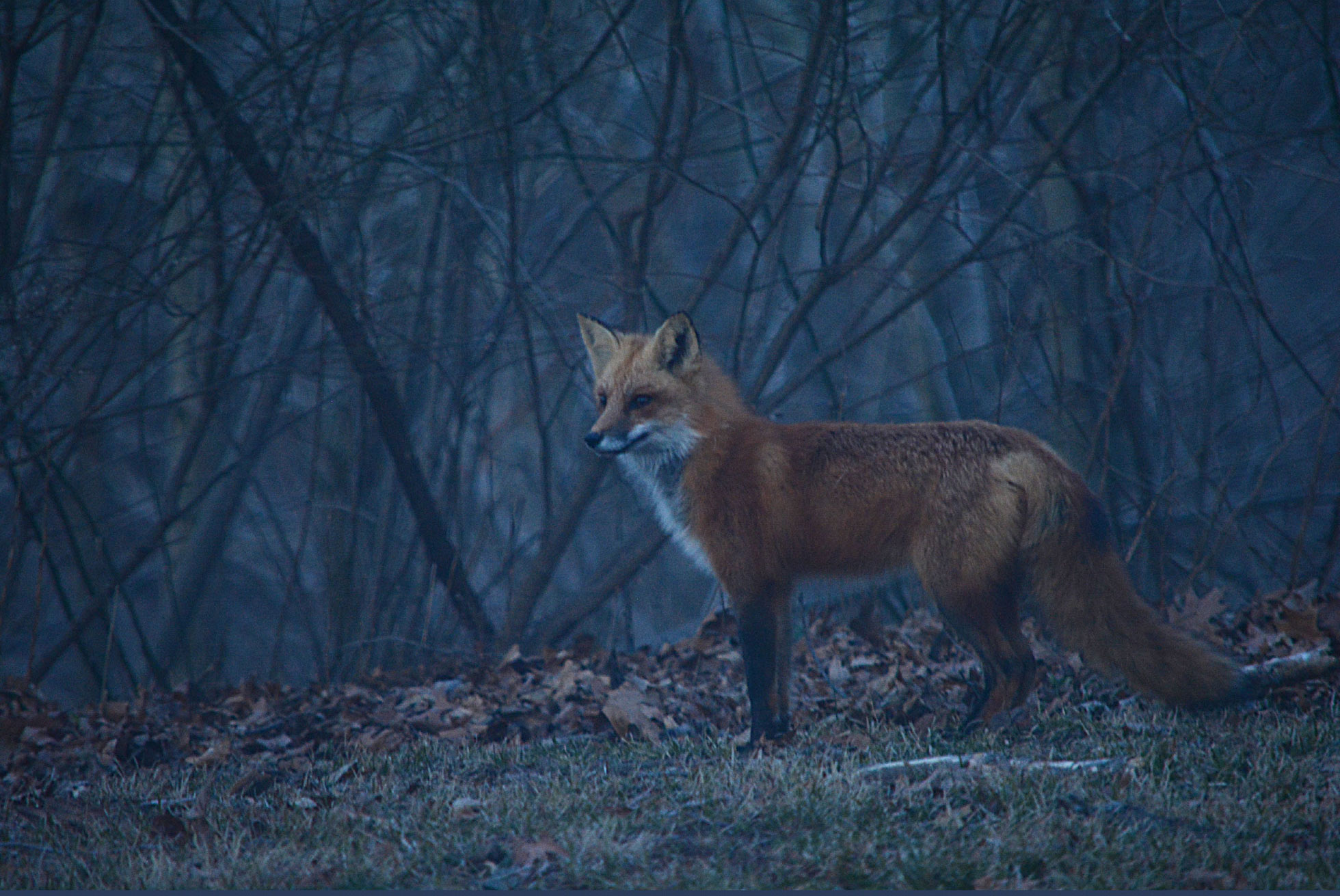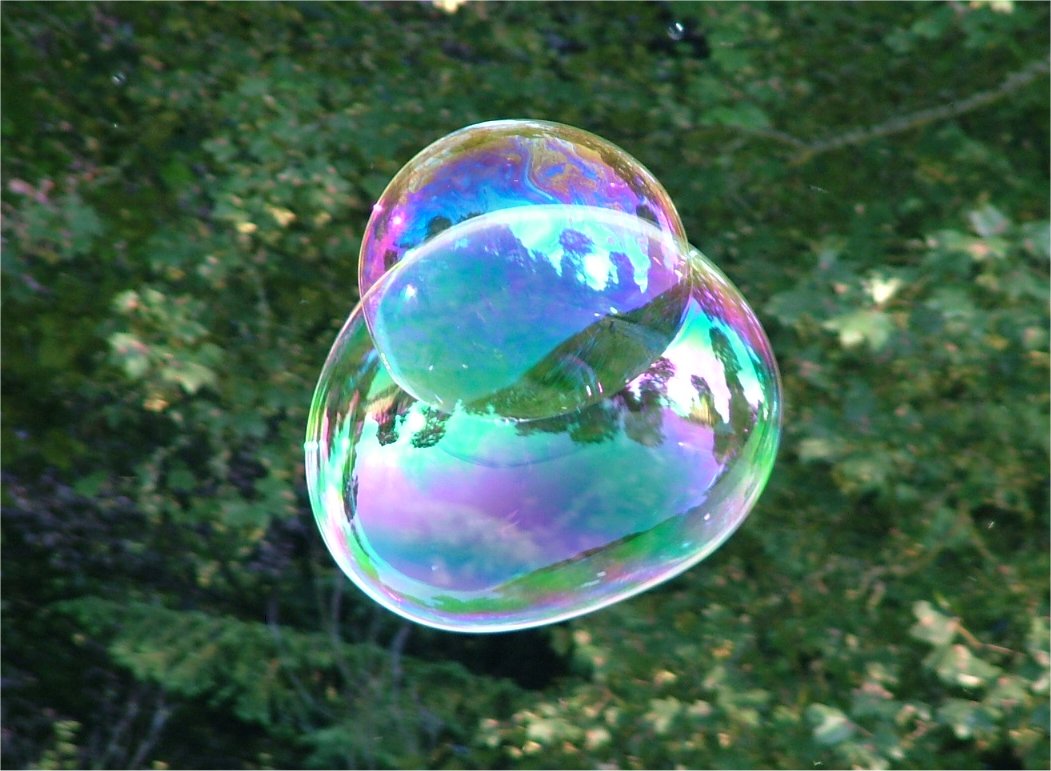|
Halictid Bee
Halictidae is the second-largest family of bees (clade Anthophila) with nearly 4,500 species. Halictid species are an extremely diverse group that can vary greatly in appearance. These bees occur all over the world and are found on every continent except Antarctica. Usually dark-colored (frequently brown or black) and often metallic, halictids are found in various sizes, colors and patterns. Several species are all or partly green and a few are red, purple, or blue. A number of them have yellow markings, especially the males, which commonly have yellow faces, a pattern widespread among the various families of bees. The family is one of many with short tongues and is best distinguished by the arcuate (strongly curved) basal vein found on the wing. Females in this family tend to be larger than the males. They are commonly referred to as "sweat bees" (especially the smaller species), as they are often attracted to perspiration. Ecology Most halictids nest in the ground, often in hab ... [...More Info...] [...Related Items...] OR: [Wikipedia] [Google] [Baidu] |
Halictus Scabiosae
''Halictus scabiosae'', the great banded furrow-bee, is a species of bee Bees are winged insects closely related to wasps and ants, known for their roles in pollination and, in the case of the best-known bee species, the western honey bee, for producing honey. Bees are a monophyly, monophyletic lineage within the ... in the family Halictidae, the sweat bees. Distribution This species is present in most of Europe and in North Africa. Description The abdomen is long, with yellowish stripes and a double band on tergites two and three. The legs are yellow and antennae are entirely black and curved at the apex. Males are very elongated and have a whitish posterior band on segments two-six of the abdomen, while the females show basal hair yellowish-beige bands on tergites two-four. This species looks very similar to a closely related species, ''Halictus sexcinctus'', and thus the two can be easily confused. These two species can be distinguished from one another in that male ... [...More Info...] [...Related Items...] OR: [Wikipedia] [Google] [Baidu] |
Lasioglossum Malachurum
''Lasioglossum malachurum'', the sharp-collared furrow bee, is a small European halictid bee. This species is obligately eusocial, with queens and workers, though the differences between the castes are not nearly as extreme as in honey bees. Early taxonomists mistakenly assigned the worker females to a different species from the queens. They are small (about 1 cm), shiny, mostly black bees with off-white hair bands at the bases of the abdominal segments. ''L. malachurum'' is one of the more extensively studied species in the genus ''Lasioglossum'', also known as sweat bees. Researchers have discovered that the eusocial behavior in colonies of ''L. malachurum'' varies significantly dependent upon the region of Europe in which each colony is located. Taxonomy and phylogeny ''L. malachurum'' was described by the entomologist William Kirby in 1802. This species of bees fall within the genus ''Lasioglossum'', which is the largest bee genus. ''Lasioglossum'' falls within the f ... [...More Info...] [...Related Items...] OR: [Wikipedia] [Google] [Baidu] |
Lasioglossum
The sweat bee genus ''Lasioglossum'' is the largest of all bee genera, containing over 1700 species in numerous subgenera worldwide.Gibbs, J., et al. (2012)Phylogeny of halictine bees supports a shared origin of eusociality for ''Halictus'' and ''Lasioglossum'' (Apoidea: Anthophila: Halictidae).''Molecular Phylogenetics and Evolution'' 65(3), 926-39. They are highly variable in size, coloration, and sculpture; among the more unusual variants, some are cleptoparasites, some are nocturnal, and some are oligolectic. Most ''Lasioglossum'' species nest in the ground, but some nest in rotten logs. Social behavior among species of ''Lasioglossum'' is extraordinarily variable; species are known to exhibit solitary nesting, primitive eusociality, and social parasitism. Colony sizes vary widely, from small colonies of a single queen four or fewer workers to large colonies of >400 workers and perennial life cycles. The genus ''Lasioglossum'' can be divided ... [...More Info...] [...Related Items...] OR: [Wikipedia] [Google] [Baidu] |
Vespertine (biology)
Vespertine is a term used in the life sciences to indicate something of, relating to, or occurring in the evening. In botany, a vespertine flower is one that opens or blooms in the evening. In zoology, the term is used for a creature that becomes active at dusk, such as bats and owls. Strictly speaking, however, the term means that activity ceases during the hours of full darkness and does not resume until the next evening. Activity that continues throughout the night should be described as nocturnal. Vespertine behaviour is a special case of crepuscular behaviour; like crepuscular activity, vespertine activity is limited to dusk rather than full darkness. Unlike vespertine activity, crepuscular activity may resume in dim twilight before dawn. A related term is matutinal, referring to activity limited to the dawn twilight. The word ''vespertine'' is derived from the Latin word ', meaning "evening". See also * Crypsis * Matutinal Matutinal, matinal (in entomological writin ... [...More Info...] [...Related Items...] OR: [Wikipedia] [Google] [Baidu] |
Crepuscular
In zoology, a crepuscular animal is one that is active primarily during the twilight period, being matutinal, vespertine, or both. This is distinguished from diurnal and nocturnal behavior, where an animal is active during the hours of daylight and of darkness, respectively. Some crepuscular animals may also be active by moonlight or during an overcast day. Matutinal animals are active only before sunrise, and vespertine only after sunset. A number of factors impact the time of day an animal is active. Predators hunt when their prey is available, and prey try to avoid the times when their principal predators are at large. The temperature at midday may be too high or at night too low. Some creatures may adjust their activities depending on local competition. Etymology and usage The word ''crepuscular'' derives from the Latin '' crepusculum'' ("twilight"). Its sense accordingly differs from diurnal and nocturnal behavior, which respectively peak during hours of daylight a ... [...More Info...] [...Related Items...] OR: [Wikipedia] [Google] [Baidu] |
Augochloropsis Metallica Male
''Augochloropsis'' is a genus of brilliant metallic, often blue-green, sweat bees in the family Halictidae. There are at least 140 described species in ''Augochloropsis''. Description and identification Species of the genus ''Augochloropsis'' are generally between 8 and 12 mm long and metallic, typically bright green or blue in color, with some exceptions such as gold, red, or purple.Mitchell, T. B. (1960). Bees of the eastern United States. ''Augochloropsis'' species can be differentiated from other Augochlorini at the genus level by the tegulae that are punctate, D-shaped, and bent inwards. Geographic distribution The genus ''Augochloropsis'' is restricted to the New World, and the vast majority of species are found in the tropical and subtropical regions.Choe, J. C., & Crespi, B. J. (Eds.). (1997). ''The evolution of social behaviour in insects and arachnids''. Cambridge University Press. Three ''Augochloropsis'' species are found in the temperate regions of North ... [...More Info...] [...Related Items...] OR: [Wikipedia] [Google] [Baidu] |
Oligochlora Semirugosa
''Oligochlora'' is an extinct genus of sweat bee in the Halictidae subfamily Halictinae. The genus currently contains six species, all of which are known from the early Miocene Burdigalian stage Dominican amber deposits on the island of Hispaniola. History and classification The genus was first described by Dr. Michael Engel in a 1996 paper published in the '' Journal of the Kansas Entomological Society''. The genus name is a combination of "Oligo", from Oligocene a possible age of the amber and "chlora" from the genus ''Augochlora'', the type genus of the tribe Augochlorini where ''Oligochlora'' is placed. Along with the genus description, the paper contained the description of the type species ''O. eickworti'' and the second species ''O. micheneri''. Dr Engel described a third species, ''O. grimaldii'' in 1997. A fourth species, ''O. rozeni'' was published in 2000 and the genus was split into two subgenera, ''Oligochlora'' (''Oligochlora'') and ''Oligochlora'' (''Sol ... [...More Info...] [...Related Items...] OR: [Wikipedia] [Google] [Baidu] |
Dufourea Novaeangliae, F, Side, Washington Co, ME 2016-04-15-21
''Dufourea'' is a genus of sweat bees in the family Halictidae Halictidae is the second-largest family of bees (clade Anthophila) with nearly 4,500 species. Halictid species are an extremely diverse group that can vary greatly in appearance. These bees occur all over the world and are found on every contine .... There are at least 160 described species in ''Dufourea''.Sharkey M.J. (2007). ''Phylogeny and Classification of Hymenoptera''."Phylogenetic relationships among superfamilies of Hymenoptera", Sharkey M.J., Carpenter J.M., Vilhelmsen L., et al. 2012. ''Cladistics'' 28(1): 80-112. See also * List of Dufourea species References * Michener, Charles D. (2000). ''The Bees of the World'', xiv + 913. * Michener, Charles D. (2007). ''The Bees of the World, Second Edition'', xvi + 953. Further reading * Halictidae Bee genera {{sweat-bee-stub ... [...More Info...] [...Related Items...] OR: [Wikipedia] [Google] [Baidu] |
Iridescent
Iridescence (also known as goniochromism) is the phenomenon of certain surfaces that appear to gradually change color as the angle of view or the angle of illumination changes. Examples of iridescence include soap bubbles, feathers, butterfly wings and seashell nacre, and minerals such as opal. It is a kind of structural coloration that is due to wave interference of light in microstructures or thin films. Pearlescence is a related effect where some or most of the reflected light is white. The term pearlescent is used to describe certain paint finishes, usually in the automotive industry, which actually produce iridescent effects. Etymology The word ''iridescence'' is derived in part from the Greek word ἶρις ''îris'' ( gen. ἴριδος ''íridos''), meaning '' rainbow'', and is combined with the Latin suffix ''-escent'', meaning "having a tendency toward". Iris in turn derives from the goddess Iris of Greek mythology, who is the personification of the rainbo ... [...More Info...] [...Related Items...] OR: [Wikipedia] [Google] [Baidu] |
Wasp
A wasp is any insect of the narrow-waisted suborder Apocrita of the order Hymenoptera which is neither a bee nor an ant; this excludes the broad-waisted sawflies (Symphyta), which look somewhat like wasps, but are in a separate suborder. The wasps do not constitute a clade, a complete natural group with a single ancestor, as bees and ants are deeply nested within the wasps, having evolved from wasp ancestors. Wasps that are members of the clade Aculeata can Stinger, sting their prey. The most commonly known wasps, such as yellowjackets and hornets, are in the family Vespidae and are Eusociality, eusocial, living together in a nest with an egg-laying queen and non-reproducing workers. Eusociality is favoured by the unusual haplodiploid system of sex-determination system, sex determination in Hymenoptera, as it makes sisters exceptionally closely related to each other. However, the majority of wasp species are solitary, with each adult female living and breeding independently ... [...More Info...] [...Related Items...] OR: [Wikipedia] [Google] [Baidu] |
Sphecodes
''Sphecodes'' is a genus of bees from the family Halictidae, the majority of which are black and red in colour and are colloquially known as blood bees. ''Sphecodes'' bees are kleptoparasitic on other bees, especially bees in the genera '' Lasioglossum'', '' Halictus'' and '' Andrena''. The adults consume nectar, but because they use other bees' provisions to feed their offspring they do not collect pollen. Distribution ''Sphecodes'' is a cosmopolitan genus with species represented on every continent. The genus is also very species rich, with 21 species described from Siberia, 33 species from Central Europe, 17 species from the Indian region, 26 from the Arabian Peninsula and surrounding region, and 21 from Southeast Asia. The genus is only represented in Australia in the northeast, with the species '' Sphecodes albilabris'' being thought to have been introduced to both Australia and the United States by accident. Species There are over 300 known species in the genus ''Sphecod ... [...More Info...] [...Related Items...] OR: [Wikipedia] [Google] [Baidu] |
Halictus Sexcinctus
''Halictus sexcinctus'', commonly referred to as the six-banded furrow bee, is a species of sweat bee found throughout Europe and as far east as Asian Turkey and Iraq.The ''H. sexcinctus'' can be easily confused with the closely related species, ''Halictus scabiosae'', due to very similar morphological features. ''H. sexcinctus'' show a social polymorphism in which different colonies can exhibit solitary, communal, or eusocial structure. Due to this large variance in social organization, it was suspected that it was not one species at all, but rather multiple, cryptic species. However, genetic analysis was able to confirm these varying populations as one species. ''H. sexcinctus'' will forage from multiple flower species, but prefers plant species with wide-open flowers. Their nests can be found dug into the ground in loamy or sandy soil. Taxonomy and phylogenetics ''Halictus sexcinctus'' is part of the family Halictidae, which are commonly referred to as the sweat bees. Species ... [...More Info...] [...Related Items...] OR: [Wikipedia] [Google] [Baidu] |


.jpg)



